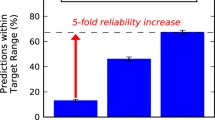Abstract
The prediction of new crystallographic materials through machine learning has allowed the save of resources in the synthesis of new compounds. The search of this material with optical properties allows to reach applications in areas such as the medicine, engineering, informatics, materials, etc. Two features from the crystallographic planes were used to predict materials, Imax and 2-theta angle. The plasmons are produced by the metals and are detected when a beam of light ultraviolet influence in the surface and through the response the plasmon is described in the features absorbance and wavelength. The method to predict is the nearest neighbor rule 1-NN (1-Nearest Neighbor) that use the Euclidean distance, the algorithm can predict several neighbors, but the best choice will be the compound that presented the plasmon with more similarity. The results show that 84% of precision is achieved for predicting metal oxides with similar optical properties by machine learning method.
Graphical abstract



Similar content being viewed by others
Data availability
The original database is available in GitHub through https://github.com/ArthurLoSo/Materials/blob/main/Base_de_datos.csv
References
N. Martín, M. Viniegra, R. Vargas, J. Garza, Óxidos nanoestructurados de metales de transición con aplicaciones en catálisis. Revista Interdisciplinaria en Nanociencias y Nanotecnología 14(26), 1–16 (2020)
J. Hernández, M.J. Ramírez, C. Ferri, Introducción a la minería de datos, 1st edn. (Pearson Prentice Hall, Pearson, 2004)
N. Baig, I. Kammakakam, W. Falath, Nanomaterials: a review of synthesis methods, properties, recent progress, and challenges. Mater. Adv. 2(6), 1821–1871 (2021)
H. Wang, D.W. Brandl, P. Nordlander, N.J. Halas, Plasmonic nanostructures: artificial molecules. Acc. Chem. Res. (2006). https://doi.org/10.1021/ar0401045
I. Malkiel, M. Mrejen, A. Nagler, U. Arieli, L. Wolf, H. Suchowski, Light: Science & Applications, p. 1–8, (2018)
J. Fang, A. Swain, R. Unni, Y. Zheng, Decoding optical data with machine learning. Laser Photonics Rev. (2020). https://doi.org/10.1002/lpor.202000422
A. Farhangfar, L. Kurgan, W. Pedrycz, A novel framework for imputation of missing values in databases. IEEE Trans. Syst. Man Cybern. (2007). https://doi.org/10.1109/TSMCA.2007.902631
B. Liu, Web Data Mining, p. 139–140, (2007)
A. Pandey, A. Jain, Comparative analysis of KNN algorithm using various normalization techniques. Modern Educ. Comput. Sci. 11, 36–42 (2017)
J. Sander, M. Ester, H.P. Kriegel, X. Xu, Density based clustering in spatial databases: the algorithm GDBSCAN and its applications. Data Min. Knowl. Disc. 2, 181–182 (1998)
D. Krstinić, M. Braović, L. Šerić, D. Božić, Multi-Label Classifier Performance Evaluation with Confusion Matrix, Computer Science & Information Technology, p. 01–14. (2020).
K. Takahashi, K. Yamamoto, A. Kuchiba, T. Koyama, Confidence interval for micro-averaged F1 and macro-averaged F1 scores. Appl. Intell. 52, 4961–4972 (2022). https://doi.org/10.1007/s10489-021-02635-5
Funding
Arturo Lopez Solórzano is grateful to CONAHCyT (Grant No. CVU 1169797) for his scholarship, we also thank Tecnológico Nacional de México for their financial support through project 17006.23-P.
Author information
Authors and Affiliations
Contributions
AL-S contributed towards collecting data, performance analysis, and written paper. ER-L contributed with the tools and the performance of analysis, and written paper. SMG contributed with the tools and the performance of analysis, and written paper. RAE contributed with the tools and the performance of analysis.
Corresponding author
Ethics declarations
Competing interests
All authors certify that they have no affiliations with or involvement in any organization or entity with any financial interest or non-financial interest in the subject matter or materials discussed in this manuscript.
Additional information
Publisher's Note
Springer Nature remains neutral with regard to jurisdictional claims in published maps and institutional affiliations.
Rights and permissions
Springer Nature or its licensor (e.g. a society or other partner) holds exclusive rights to this article under a publishing agreement with the author(s) or other rightsholder(s); author self-archiving of the accepted manuscript version of this article is solely governed by the terms of such publishing agreement and applicable law.
About this article
Cite this article
Lopez-Solorzano, A., Rendon-Lara, E., Martínez-Gallegos, S. et al. Classification of crystallographic materials through machine learning. MRS Advances (2024). https://doi.org/10.1557/s43580-024-00796-2
Received:
Accepted:
Published:
DOI: https://doi.org/10.1557/s43580-024-00796-2




